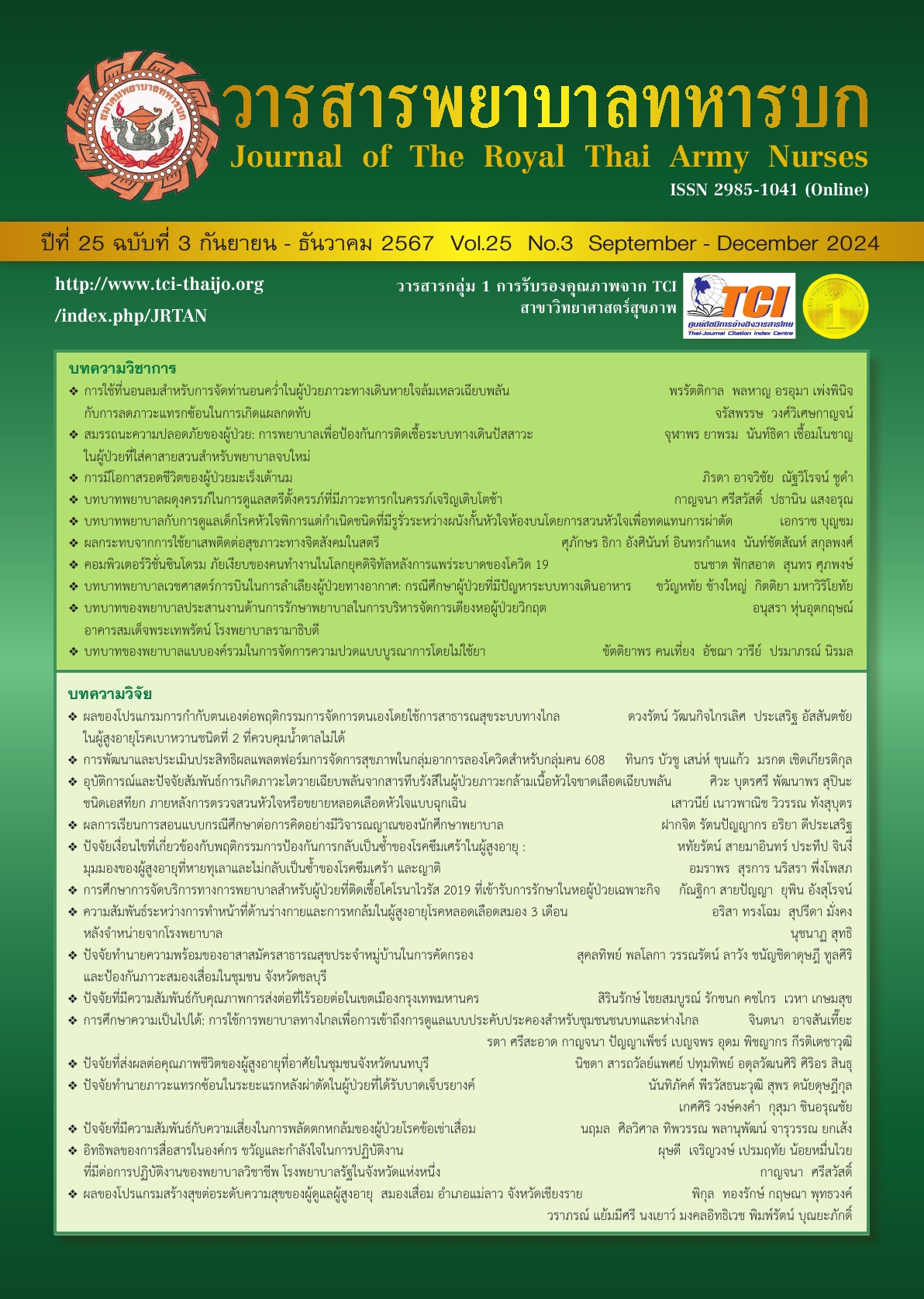Factors Associated with Fall Risks among Older Patients of Inpatient Department in a Secondary Hospital
Keywords:
older patients, factors, fall risks, inpatient departmentAbstract
The objective of this cross-sectional descriptive research was to study factors associated with fall risks among older patients in the inpatient department of a secondary hospital. The sample included 110 inpatients aged 60 years and over, recruited through purposive sampling. This method selected individuals who were conscious and able to communicate in Thai. The research tools included a record form documenting factors related to fall risks, eye health screening, the Mini Nutritional Assessment, and the Morse fall scale. The reliability of these instruments was assessed using the test-retest method, yielding stability coefficients (r) ranging from .96 to 1.0. Data analysis involved frequency statistics, percentages, means, standard deviations, Fisher’s exact probability test, and the Chi-square test.
The research results revealed that a total of 85 people (77.3%) were at risk of falling. Factors significantly related to the risk of falls (p < .001) included nutritional status, urinary incontinence, vision, history of COVID-19 infection, and the group of medications received.
The recommendation from this research is that nurses should pay particular attention to monitoring and preventing falls in older patients with undernutrition, urinary incontinence, vision problems, a history of COVID-19 infection, or older patients who received medications related to the Central Nervous System or Cardiovascular System.
Downloads
References
Boongird C. Falling in the older adults prevention and management in family medicine. Bangkok: Sahamit pattana printing company limited; 2018. (in Thai)
Senarphitak L, Piyakhachornrot C. Fear of Falling after Hip Fracture. Journal of The Royal Thai Army Nurses. 2023; 24(1): 35-42. (in Thai)
Institute of Geriatric Medicine. Medical practice guidelines for prevention and evaluation of falls in the elderly. Bangkok: Sinthavee printing Co., Ltd; 2017 (in Thai)
Eglseer D, Hoedl M, & Schoberer D. Malnutrition risk and hospital-acquired falls in older adults: A cross-sectional, multicenter study. Geriatrics & gerontology international. 2020; 20(4): 348–53.
Ishida Y, Maeda K, Nonogaki T, Shimizu A, Yamanaka Y, Matsuyama R, et al. Malnutrition at Admission Predicts In-Hospital Falls in Hospitalized Older Adults. Nutrients. 2020; 12(2): 531-41.
Lackoff A, Hickling D, Collins P, Stevenson K, Nowicki T, & Bell J. The association of malnutrition with falls and harm from falls in hospital inpatients: Findings from a 5-year observational study. Journal of clinical nursing. 2020; 29(3-4): 429–36.
Moon S, Chung HS, Kim YJ, Kim SJ, Kwon O, Lee YG, et al. The impact of urinary incontinence on falls: A systematic review and meta-analysis. PloS one. 2021; 16(5): e0251711.
Seppala LJ, Wermelink AMAT, de Vries M, Ploegmakers KJ, van de Glind EMM, Daams JG, et al. Fall-Risk-Increasing Drugs: A Systematic Review and Meta-Analysis: II. Psychotropics. Journal of the American Medical Directors Association. 2018; 19(4): 371.e11–17.
de Vries M, Seppala LJ, Daams JG, van de Glind EMM, Masud T, van der Velde N, et al Fall-Risk-Increasing Drugs: A Systematic Review and Meta-Analysis: I. Cardiovascular Drugs. Journal of the American Medical Directors Association. 2018; 19(4): 371.e1–9.
Seppala LJ, van de Glind EMM, Daams JG, Ploegmakers KJ, de Vries M, Wermelink AMAT, et al. Fall-Risk-Increasing Drugs: A Systematic Review and Meta-analysis: III. Others. Journal of the American Medical Directors Association. 2018; 19(4): 372.e1–372.e8.
Najafpour Z, Godarzi Z, Arab M, & Yaseri M. Risk Factors for Falls in Hospital In-Patients: A Prospective Nested Case Control Study. International journal of health policy and management. 2019; 8(5): 300–6.
Shuyi O, Zheng C, Lin Z, Zhang X, Li H, Fang Y, et al. Risk factors of falls in elderly patients with visual impairment. Frontiers in public health. 2022.
Gawronska K, & Lorkowski J. Falls as One of the Atypical Presentations of COVID-19 in Older Population. Geriatric orthopaedic surgery & rehabilitation. 2021; 12: 2151459321996619.
Thato R. Nursing research: Concepts to application. Bangkok: Degree vision company limited; 2021 (in Thai)
Ministry of Public Health. Manual for Screening and Health Assessment of the Elderly 2021. Bangkok: Bangkok: Divis ion of Non Communicable Disease; 2021 (in Thai)
Vellas B, Villars H, Abellan G, Soto ME, Rolland Y, Guigoz Y, et al. Overview of the MNA-Its history and challenges. The journal of nutrition, health & aging. 2006; 10(6): 456–65.
Morse JM, Morse RM, & Tylko, SJ. Development of a scale to identify the fall-prone Patient. Canadian Journal on Aging. 1989; 8(4): 366–77.
Limpawattana P. Geriatric syndromes and interesting health issues. Khon Kaen: Klungnana Vitthaya Press; 2017 (in Thai)
Panutat S, Chuto C, Nuntawan C, Pumsrisawat A, & Pruksacheva T. Caring for the Elderly with Malnutrition. Journal of Ratchathani Innovative Health Sciences. 2017; 1(1): 1-15 (in Thai)
Tipkanajanaraykha K, & Saleeku S. Role of Nurses in Prevention and Management of Inappropriate Medication Use in Older Adults. Journal of The Royal Thai Army Nurses. 2019; 20(1): 31-9
Saftari LN, & Kwon OS. Ageing vision and falls: a review. Journal of physiological Anthropology. 2018; 37(1) : 1-14
Alghadir AH, Alotaibi AZ, & Iqbal ZA. Postural stability in people with visual impairment. Brain and behavior. 2019; 9(11): e01436.
Mao L, Jin H, Wang M, Hu Y, Chen S, He Q, et al. Neurologic Manifestations of Hospitalized Patients With Coronavirus Disease 2019 in Wuhan. China. Journal of the American Medical Association Neurology. 2020; 77(6): 683–90.
Downloads
Published
How to Cite
Issue
Section
License
Copyright (c) 2024 Journal of The Royal Thai Army Nurses

This work is licensed under a Creative Commons Attribution-NonCommercial-NoDerivatives 4.0 International License.
บทความหรือข้อคิดเห็นใดใดที่ปรากฏในวารสารพยาบาลทหารบกเป็นวรรณกรรมของผู้เขียน ซึ่งบรรณาธิการหรือสมาคมพยาบาลทหารบก ไม่จำเป็นต้องเห็นด้วย
บทความที่ได้รับการตีพิมพ์เป็นลิขสิทธิ์ของวารสารพยาบาลทหารบก
The ideas and opinions expressed in the Journal of The Royal Thai Army Nurses are those of the authors and not necessarily those
of the editor or Royal Thai Army Nurses Association.






